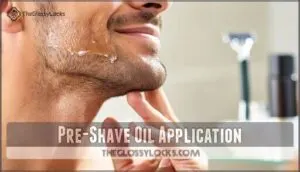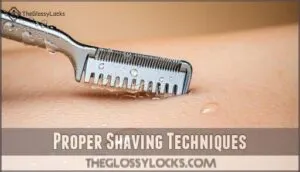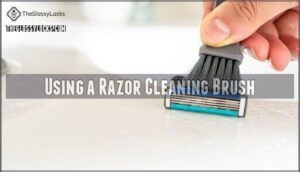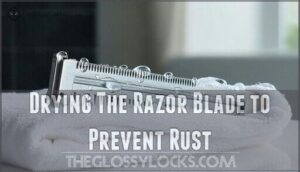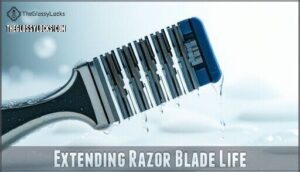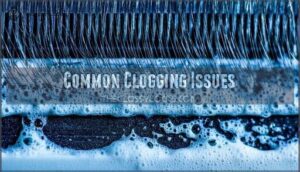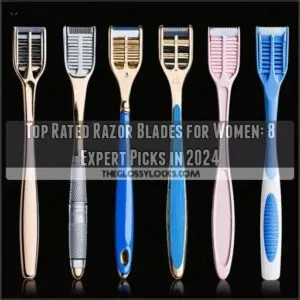This site is supported by our readers. We may earn a commission, at no cost to you, if you purchase through links.

Rinse your razor frequently during shaving—don’t let hair and lather build up like rush hour traffic. Use quality shaving cream and load your brush properly; cheap soap won’t cut it.
Shave with gentle pressure in short sections, following your hair’s natural grain. After each shave, clean your razor with warm water and a cleaning brush, then dry it thoroughly. Store it in a dry spot to prevent rust. Smart maintenance beats constant frustration every time.
Table Of Contents
- Key Takeaways
- Identifying Clogging Causes
- Pre-Shave Preparation
- Proper Shaving Techniques
- Preventing Clogs During Shaving
- Post-Shave Maintenance
- Extending Razor Blade Life
- Common Clogging Issues
- Avoiding Razor Burn and Irritation
- Choosing The Right Razor
- Troubleshooting Razor Blade Clogs
- Frequently Asked Questions (FAQs)
- How to clean a clogged razor?
- Can a dull razor clog your razor?
- How do I prevent my multi-blade razor from clogging?
- What happens if a razor is clogged?
- How to avoid clogging your razor with hair strands?
- Can a sharp razor clog a shave?
- Why is my razor clogged with lather & stubble?
- How do I Stop my razor from clogging?
- Why is my razor clogged during a shave?
- Why does my razor keep clogging?
- Conclusion
Key Takeaways
- You’ll prevent most clogs by rinsing your razor frequently during each shave—don’t let hair and lather build up between strokes like rush hour traffic.
- Your blade alignment and water quality matter more than you think—hard water and misaligned blades create the perfect storm for constant clogging issues.
- You can extend blade life and reduce clogs by using quality shaving cream, proper brush loading techniques, and storing your razor in a dry place after thorough cleaning.
- You’ll get smoother shaves by following simple maintenance habits: shave with the grain, use gentle pressure, replace dull blades regularly, and clean with warm water and a brush after each use.
Identifying Clogging Causes
You’ll notice clogged blades can turn a smooth shave into a hassle, but it’s usually just a sign of common issues like hard water, unbalanced blade alignment, or low-quality lather.
If you’ve ever skipped a good brush loading or grabbed cheap shaving soap, you know clogs aren’t just annoying—they can throw off your whole routine.
Misaligned Blades
A crooked blade can turn your morning shave into a bumpy ride. Misaligned blades often cause shaving discomfort and uneven shaves, and may even lead to razor clogging. Stay on top of things by checking for blade alignment issues regularly.
Here’s what to look out for:
- Razor blade damage or bends
- Difficulty during razor cleaning
- Rough, patchy results
Hard Water Issues
Almost always, hard water is a silent troublemaker in your shaving routine. Mineral buildup and soap scum gang up inside your razor, leaving blades dull and sticky.
Want smoother shaves? Tackle razor clogging with:
- Water softeners to fight scale prevention
- Filtered water for easy razor cleaning
- Special soaps for hard water
To avoid inflammation and blemishes, cleaning razor blades is key. Stay sharp—clean often!
Insufficiently Loaded Brush
If you’ve just switched up your water and noticed trouble building a good lather, the brush could be to blame. Underloading is a top reason for brush loading issues and lather consistency problems. A dense-bristled brush holds more cream, giving you better coverage and control.
Swirl your brush for 15-20 seconds, adjust the soap-to-water ratio, and don’t be shy about testing different brands to see what works for you. Check this table for some quick hits:
Brush Quality
Brush Loading
Proper brush technique now means fewer razor clogging headaches later.
Mediocre Shaving Soap
Using poor ingredients in a shaving soap is like putting watered-down fuel in a sports car—it just sputters. A mediocre lather causes clogging and skin irritation.
To dodge razor clogging, try these:
- Choose water soluble shaving cream.
- Prioritize lather quality.
- Consider soap alternatives for sensitive skin.
- Make razor cleaning and maintenance a habit.
Pre-Shave Preparation
You’ll get a smoother, safer shave if you prep your skin correctly before picking up the razor. Take a minute to wet your face, exfoliate away dead skin, and create a barrier with quality cream—your blades and skin will thank you later.
Wetting Techniques for Razor Blade
Soaking your razor blade in lukewarm water for about 30 seconds—think of it as a quick pit stop—makes a big difference. Warm water, not hot, boosts blade hydration and keeps shaving smooth, while hot water shortens blade life and cold water invites clogs. Hard water can cause mineral buildup, so always use a good wetting agent. Razor cleaning starts here.
Soak your razor in lukewarm water for thirty seconds—it’s like a quick pit stop that makes all the difference
| Blade Soaking Time | Water Temperature Effects | Wetting Agent Use |
|---|---|---|
| 30 seconds | Warm water hydrates | Pre-shave oil |
| Less effective if shorter | Hot water dulls blades | Glycerin-based |
| Longer if mineral-rich water | Cold water clogs | Water-soluble gel |
| Change water for each shave | Prevents hard water residue | Mild soap |
| Key for razor cleaning | Reduces drag | Enhances glide |
Exfoliating Skin Before Shaving
Once your razor’s had a good soak, don’t skip exfoliation. Clearing away dead cells gives you a cleaner shave and helps prevent clogged blades. Pick the right scrub—some suit sensitive skin, others work best on thicker beards.
Here’s your quick-hit checklist:
- Exfoliation Benefits
- Scrub Types
- Technique Matters
- Frequency Guide
- Sensitive Skin Tips
Choosing The Right Shaving Cream
When you’re selecting the right shaving cream, ingredient analysis matters. Match your pick to your skin type, and don’t overlook scent preferences—fragrances aren’t for everyone. Good lather quality cushions the blade and keeps things smooth. Consider that shaving gel offers better visibility during shaving, which is a key difference. Compare cream alternatives, shaving oils, and fluffy shave butters if you want less clogging.
Here’s a quick comparison to help you out:
| Shaving Product | Lather Quality | Easy Rinse? |
|---|---|---|
| Classic Cream | Thick, fluffy | Sometimes |
| Gel or Oil | Thin, slick | Usually |
| Fluffy Shave Butter | Rich, creamy | Often |
Pre-Shave Oil Application
Sliding pre-shave oil between your skin and razor boosts lubrication, making each stroke easier. Oil benefits? Think smoother shaves, less tugging. Just massage a few drops before lathering Shaving Cream. Prefer water-soluble blends for easy residue removal. Shave Oil fits all skin types—experiment to find your match. Good application methods equal first-rate shaving techniques.
- Helps prevent nicks and cuts
- Reduces razor drag
- Softens stubble before shaving
- Works well with most Shaving Creams
- Rinses easily, keeping blades clear
Proper Shaving Techniques
Stick to gentle, steady strokes and let the blade’s angle work for you—no need to press down like you’re flattening a pancake.
Shaving in the direction of hair growth keeps your skin happy and reduces the risk of gunk building up in the razor.
Maintaining The Correct Blade Angle
After solid pre-shave prep, lock in the best angle—think about a 30-degree tilt, with the blade’s edge just brushing the skin. This gives you great Pressure Control and prevents skin nicks or clogging from gunk caught between blade and lather.
Keep your wrist steady; Angle Consistency is your secret weapon. Let the razor do most of the work and monitor Skin Contact. With good technique, blade angle fine-tuning improves the cut and keeps razor maintenance low and cleaning a breeze.
Shaving in The Direction of Hair Growth
When you shave following your hair growth patterns, you’re stacking the odds in your favor—think of it like mapping out a smooth highway for that razor blade. Beard mapping helps you understand that multi-directional growth, cutting down on irritation and ingrown hair.
This shaving tip prevents razor blade clogging and nicks, especially if you’ve got sensitive skin. It’s simple: lather with quality shaving cream, let the blade do the work, and rinse thoroughly for easy razor cleaning. Try this approach, and you’ll see how proper shaving techniques pay off with a cleaner face.
Applying Gentle Pressure
You only need a little pressure for effective shaving comfort—think of it as guiding, not grinding. Check your technique with these four steps:
- Grip the handle lightly to boost Pressure Sensitivity.
- Rely on the blade’s weight for even Blade Contact.
- Use a steady hand for Glide Efficiency.
- Ease up near sensitive areas to minimize Skin Irritation.
Avoiding Over-Shaving
Ever wonder why your skin gets irritated after a shave? Over-shaving causes more harm than help—think irritation, razor blade clogging, and ingrown hairs.
Use efficient strokes and minimal passes, not endless swipes. Stick with a comfortable shaving frequency, keep shaving cream light, and don’t forget razor cleaning.
Smart shaving tips lead to happier, less sensitive skin.
Preventing Clogs During Shaving
You want a smooth shave without stopping every few strokes to tap hair out of the blades, so keep your razor rinsed and let water do the heavy lifting between passes.
Don’t be shy about using razors with anti-clog tech—because nobody wants their morning routine slowed down by stubborn stubble.
Rinsing The Razor Blade Regularly
Gliding your razor smoothly relies on more than just technique—it’s about smart habits. Rinsing Frequency matters: pause every couple of swipes for Immediate Rinsing, waving the head under warm water. The right Water Temperature helps dissolve Product Buildup, preventing razor blade clogging.
Make sure the Rinsing Direction runs from the back to the front—this Razor Cleaning Method flushes out trapped hairs effectively. Stick to regular Cleaning Razor routines between strokes to keep blades sharp and skin safe. Razor Maintenance isn’t just about longevity; it keeps your shave smooth and trouble-free.
Using a Razor With Anti-Clog Features
A razor with anti-clog features can cut hassle in half. Thanks to open flow design, blade spacing, and lubrication strips, you’ll spend less time on razor cleaning and see fewer clogs—no more fighting soap-scum creatures.
Here’s why to try one:
- Quick rinsing
- Consistent performance
- Prolonged blade life
- Cleaner, safer shaves
Shaving in Sections to Reduce Hair Buildup
Tackling your shave one small area at a time—think of it as “Sectional Shaving”—is a smart way to keep Hair Buildup from turning into Razor blade clogging chaos. By working through each patch like a puzzle, you get improved Blade Efficiency, easier Razor cleaning, and Reduced Clogging.
This method also means shaving cream stays where you need it. Shaving in smaller sections controls Shaving Frequency and lets you focus on hygiene. Clean, consistent passes also make Razor maintenance fast and simple—your skin, and your morning, will thank you.
Avoiding Shaving Over The Same Spot
When you skip repeated strokes, you minimize redundancy and lower the chance of razor blade clogging. Stick to single pass shaving and rely on smooth, efficient strokes for Glide Enhancement. This keeps your skin safe and blades sharp:
- Cut down on over-shaving with proper lubrication.
- Let shaving cream guide your strokes.
- Clean your razor regularly for best results.
Post-Shave Maintenance
Once you’re finished shaving, a little post-shave maintenance keeps your razor in top shape and helps prevent nasty surprises like rust or buildup.
Always rinse, dry, and store your blade properly—you don’t want yesterday’s stubble joining you for tomorrow’s shave.
Cleaning The Razor Blade With Warm Water
After preventing clogs during shaving, proper cleaning becomes your next line of defense. Warm water works wonders for razor cleaning—the Water Temperature Effects help dissolve stubble and soap residue effectively. Your Rinsing Technique Matters: hold the razor under moderate flow, angling it so water flows through blade gaps. The Warm Water Benefits include softening debris for easier removal. Cleaning Frequency Impact shows immediate results when you rinse after every few strokes, not just at the end.
| Water Pressure Variance | Razor Care Result |
|---|---|
| Too gentle | Stubble remains trapped |
| Moderate flow | Perfect debris removal |
| Too forceful | Blade damage risk |
| Intermittent bursts | Incomplete cleaning |
| Steady stream | Razor Cleaning Methods at their best |
Using a Razor Cleaning Brush
After cleaning with warm water, grab a razor cleaning brush to tackle stubborn debris. Your cleaning brush technique should involve gentle circular motions around blade edges. This razor maintenance step prevents buildup that warm water can’t remove alone.
Brush bristle type matters – soft synthetic bristles work best for delicate blades, while firmer options handle tough clogs. Brush material impact shows synthetic bristles outlast natural ones and resist bacteria buildup.
For alternative brush options, old toothbrushes work in a pinch. Proper brush storage tips include air-drying completely before storing.
Drying The Razor Blade to Prevent Rust
After cleaning your razor blade, shake off excess water and pat dry with a clean towel. This blade rust prevention step extends sharpness life quite a bit.
Consider these drying methods compared:
- Air dry completely – Natural evaporation prevents material degradation factors
- Gentle towel pat – Removes moisture without damaging blade edges
- Hair dryer (cool setting) – Speeds process in humid environments
Proper razor maintenance through thorough drying keeps your razor blade performing optimally between shaves.
Storing The Razor in a Dry Place
Proper storage transforms razor maintenance from chore to simple habit. You’ll extend blade longevity by keeping your razor in a well-ventilated, dry environment away from bathroom humidity. This prevents rust formation and mold growth that compromises razor performance.
- Ventilated cabinet: Store away from steamy shower areas
- Razor stand: Allows airflow around blades for complete drying
- Dedicated drawer: Keep separate from wet bathroom items
- Regular inspection: Check monthly for early rust or damage signs
Extending Razor Blade Life
You’ll extend your blade’s lifespan considerably by changing it regularly before it becomes dull, usually every 5-7 shaves depending on your hair thickness.
Regular sharpening with a blade sharpener or stropping can also maintain the cutting edge, while choosing multi-blade razors with protective strips helps reduce wear from repeated passes.
Changing The Razor Blade Regularly
After proper cleaning and drying, replace your razor blades when they start tugging or pulling. Dull blades create more clogging issues than sharp ones. Fresh razor blades cut cleanly through hair without forcing debris into blade gaps. Blade replacement frequency depends on your hair thickness and shaving habits.
| Blade Material | Replacement Frequency | Cost vs Performance |
|---|---|---|
| Stainless Steel | 5-7 shaves | Budget-friendly option |
| Carbon Steel | 3-5 shaves | Sharp but requires care |
| Ceramic Coated | 8-10 shaves | Higher cost, longer lasting |
| Platinum Coated | 10-12 shaves | Premium performance |
| Multi-blade Cartridge | 6-8 shaves | Convenient but expensive |
Sharpening The Razor Blade
Three simple honing techniques transform dull razor blades into sharp razors. Use leather stropping methods between shaves to realign the blade edge.
Apply honing stones every few weeks depending on sharpening frequency and blade materials. Choose fine abrasive compounds for best results.
This razor blade sharpening extends blade life greatly while maintaining peak cutting performance.
Using a Razor Blade Sharpener
Beyond basic maintenance, sharpening razor blades with proper tools transforms your shaving experience. Different sharpener types suit various needs, from manual honing devices to electric units. Regular sharpening frequency depends on usage, but weekly maintenance works for most shavers.
Key considerations for effective razor blade sharpening:
- Angle consistency during sharpening maintains blade geometry and performance
- DIY sharpening methods using leather strops or denim can extend blade longevity between professional services
- Razor maintenance includes thorough razor cleaning before and after sharpening sessions
Quality sharpeners restore dull edges efficiently, making razor blade sharpening worthwhile for frequent shavers seeking peak performance.
Considering a Razor With a Long-Lasting Blade
Smart shoppers know that blade material matters most. Steel blades clog faster than premium options with specialized blade coatings. When razor blade clogging becomes frequent, consider razors with ceramic or stainless steel construction.
Quality handle design and proper razor weight reduce pressure, preventing clogs. These razors need less razor maintenance and razor cleaning. Your razor blade care routine becomes simpler with long-lasting blades that resist buildup.
Common Clogging Issues
You’ll encounter three main culprits that turn your morning shave into a frustrating battle: lather and stubble mixing into a thick paste, individual hairs wedging between blade edges, and complete razor lockup where nothing moves through the cartridge.
Understanding these common blockages helps you spot problems early and choose the right clearing technique for each situation.
Lather and Stubble Buildup
When lather consistency goes wrong, you’ll get paste-like buildup that clogs your razor fast. Poor stubble density prep creates product residue that sticks to blades.
Rinse your razor with warm water every few strokes – increase rinsing frequency when using thick shaving cream or shaving oil.
Good razor maintenance prevents razor blade clogging before it starts.
Hair Clogging The Razor
Hair density affects how quickly your razor clogs during shaving. Thicker hair and daily shaving frequency create more buildup in blade spacing.
Here’s how to handle hair clogging:
- Soften stubble with warm water for easier hair removal
- Rinse your razor after every few strokes for effective clog removal
- Use proper cleaning razor techniques with back-to-front water flow
- Maintain consistent razor care through regular blade inspection
Smart razor maintenance prevents frustrating mid-shave interruptions.
Razor Blade Lockup
When your razor locks up mid-shave, it’s like hitting a brick wall. Clogged cartridges from shaving gel buildup prevent smooth razor head pivoting. Handle grip problems and blade angle issues worsen the jam.
Dull blades can’t cut through debris effectively. Regular cleaning razor and proper lubrication prevent razor blade clogging. Good razor maintenance keeps everything moving smoothly.
Avoiding Razor Burn and Irritation
You’ll want to prepare your skin properly before shaving to prevent razor burn and minimize irritation that can worsen blade clogging.
Exfoliate gently to remove dead skin cells, then shave with the grain or slightly across it to reduce friction and maintain smooth blade performance.
Exfoliating Before Shaving
Beyond clogging issues, proper exfoliation methods help prevent razor blade clogging entirely. This skin care routine step removes dead cells that mix with shaving cream, creating paste-like buildup.
Use gentle scrub ingredients suited for sensitive skin types. Frequency matters—exfoliate 2-3 times weekly to prevent ingrown hairs.
Your shaving techniques improve dramatically when you prep correctly. Clean skin means smoother strokes and less blade resistance.
Shaving With or Across The Grain
After exfoliating, understanding your hair’s direction becomes critical for preventing razor blade clogging. Grain mapping helps you identify hair growth patterns before shaving. This knowledge directly impacts your irritation levels and efficient cutting performance.
Here’s your grain-direction strategy:
- Map your hair growth – Run your hand across different face areas to feel resistance
- Start with the grain – First pass follows natural hair direction for comfort
- Consider across-the-grain – Second pass perpendicular to growth if needed
Hair density and personal preference determine your approach. These shaving techniques prevent clogs while maintaining proper razor maintenance. Remember, aggressive hair removal techniques cause more problems than they solve.
Choosing The Right Razor
You’ll prevent most clogging problems by selecting a razor that matches your beard type and hair thickness. Multi-blade cartridges with anti-clog features work best for thick, coarse hair, while single-blade safety razors handle fine hair without excessive buildup.
Selecting a Razor for Your Beard Type
Your beard’s density and hair thickness determine your razor’s success. For coarse, thick beards, choose multiblade razors with wider blade spacing to handle heavy stubble without clogging. Fine hair needs single-blade precision.
Skin sensitivity calls for gentler options with fewer blades. Match your razor features to your beard type for best razor maintenance and shaving cream performance.
Considering a Razor With Anti-Clog Features
Smart shopping can transform your shaving experience from frustrating to superb. Modern razors with anti-clog features tackle the root problem before it starts.
- Blade spacing: Wider gaps between razor blades prevent hair and lather buildup
- Open comb design: Creates better flow-through design for debris removal
- Cartridge options: Pivoting head razors adjust to face contours, reducing snags
- Flow-through channels: Built-in rinsing paths keep razor blades clear during use
These features mean less time cleaning razor heads and more consistent performance. You’ll spend less effort on razor maintenance and get smoother results every time.
Comparing Costs and Blade Longevity
The right razor balances Blade Material Costs with performance. Cartridge Price Comparison reveals disposables seem cheaper upfront, but Long-Term Shaving Savings favor quality Razor Blades. Consider Sharpening vs. Replacement costs when evaluating Disposable Razor Economics.
| Razor Type | Initial Cost | Cost Per Shave |
|---|---|---|
| Disposable | $2-5 | $0.15-0.30 |
| Cartridge | $15-30 | $0.50-1.00 |
| Safety | $20-50 | $0.05-0.15 |
| Electric | $50-200 | $0.02-0.10 |
Troubleshooting Razor Blade Clogs
When your razor clogs mid-shave, don’t panic—it’s one of the most common shaving frustrations you’ll face.
You can quickly unclog blades by rinsing from back to front under warm tap water, then identify what’s causing the problem to prevent future buildup.
Unclogging a Razor Blade
When your razor gets gunked up with stubborn clogs, don’t panic. Start with immediate unclogging steps: rinse under hot tap water from back to front. Use tool-assisted unclogging with a clean toothbrush for stubborn clog removal. Shake excess debris loose, then apply proper lubrication for smooth operation.
- Pro tip: Soak in a warm vinegar solution for disinfection and mineral buildup removal from hard water.
This razor maintenance keeps blades functioning optimally.
Identifying and Resolving Underlying Issues
Finding patterns helps you stop razor blade clogging before it starts. Check if hard water creates mineral buildup on your razor.
Review your shaving habits – poor technique refinement and product compatibility issues cause most problems.
Examine skin condition impact from inadequate prep work.
Proper root cause analysis of your shaving cream choice and razor care routine prevents future cleaning razor headaches.
Regular Maintenance for Clog Prevention
The secret to preventing razor blade clogging lies in consistent maintenance. Follow proper blade cleaning frequency by rinsing after each stroke, especially with hard water. Use proper drying methods and implement smart storage best practices in ventilated areas.
Master sharpening techniques and nail down blade replacement timing. Your cleaning razor routine becomes second nature, transforming razor care from chore to habit. These razor maintenance tips keep your blade performing like new.
Frequently Asked Questions (FAQs)
How to clean a clogged razor?
Turn off your razor and rinse it under warm running water from back to front. Use a small brush or toothbrush to gently scrub between the blades, removing trapped hair and buildup completely.
Can a dull razor clog your razor?
Every stroke dulls blades slightly, making cutting harder. Dull blades definitely clog your razor more often.
They struggle cutting hair cleanly, creating ragged ends that stick together with shaving cream, forming paste-like buildup between blade gaps.
How do I prevent my multi-blade razor from clogging?
Rinse your razor frequently during shaving with warm water, use quality water-soluble products, shave with proper blade angle, and replace blades regularly when they become dull or damaged.
What happens if a razor is clogged?
Ever wonder why your shave feels like sandpaper? A clogged razor drags across your skin, causing irritation, razor burn, and missed whiskers.
You’ll need more passes, increasing nicks and discomfort while wasting time.
How to avoid clogging your razor with hair strands?
Keep your razor sharp by replacing dull blades regularly. Rinse thoroughly after each stroke, shave with grain direction, use quality shaving cream, and store in dry conditions to prevent hair buildup.
Can a sharp razor clog a shave?
Sharp razors rarely clog themselves – it’s usually poor technique that’s the culprit.
You’re more likely experiencing buildup from inadequate rinsing, thick shaving cream, or skipping pre-shave prep that softens whiskers properly.
Why is my razor clogged with lather & stubble?
Your razor’s clogged because you’re using too much lather or shaving cream. Thick products create paste-like buildup when mixed with cut stubble. Try thinner, water-soluble products and rinse frequently.
How do I Stop my razor from clogging?
Rinse your razor frequently during shaving with warm water, use quality water-soluble products, maintain proper blade angle, and replace dull blades regularly to prevent stubble buildup.
Why is my razor clogged during a shave?
Your razor’s getting clogged because hair, dead skin cells, and shaving cream are building up between the blades. You’re probably not rinsing enough between strokes or using too thick products.
Why does my razor keep clogging?
Coincidentally, most clogging happens when you’re rushing through your morning routine. Dull blades struggle with thick hair, creating buildup. Dead skin cells mix with stubble, forming paste-like clogs. You’re probably skipping proper pre-shave prep too.
Conclusion
Think of razor maintenance like keeping a sports car running smoothly—neglect the basics and you’ll face constant breakdowns. When you troubleshoot razor blade clogging consistently, you’re investing in better shaves and longer blade life.
Remember: proper preparation, gentle technique, and thorough cleaning prevent most issues. Rinse frequently, use quality products, and store your razor dry.
These simple habits transform daily shaving from a frustrating chore into a smooth, efficient routine that saves time and money.
- https://athenaclub.com/blogs/news/why-does-my-razor-get-clogged-and-how-to-prevent-it
- https://www.reddit.com/r/shaving/comments/7mnt7k/how_do_multiblade_users_stop_hair_clogging_the/
- https://wecare.shave.com/support/solutions/articles/5000524606-my-razor-blades-seem-to-be-clogging-how-do-i-prevent-this-
- https://new-beauty.com/blog/laser-hair-removal-treatments/shaving-problems/
- https://hensonshaving.com/pages/technical-data




